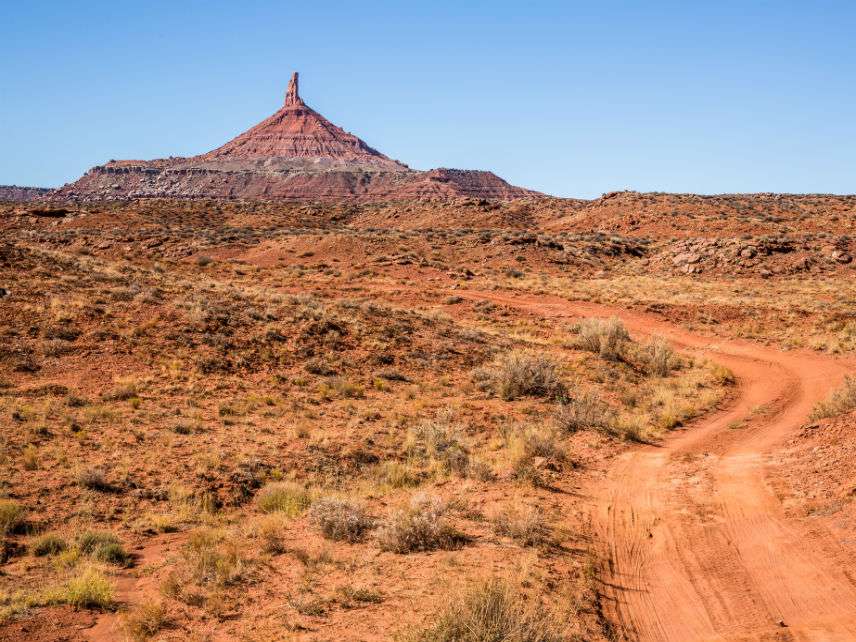Trump Just Made Two National Monuments Smaller. How Big a Deal Is That?
The feds still own the land.

President Donald Trump issued proclamations yesterday reducing the sizes of two national monuments in southern Utah. Bears Ears is being shrunk from 1.35 million acres to just over 200,000; Grand Staircase/Escalante is being brought down from 1.7 million acres to 1 million.
President Barack Obama proclaimed the creation of the Bears Ears National Monument just three weeks before the end of his administration, and President Bill Clinton similarly created the Grand Staircase/Escalante National Monument in 1996. In both cases, many local Utahns and their representatives in Congress fiercely opposed the changes, arguing that the designations would bar their access to the mineral, timber, and grazing resources needed to support their communities. Earlier this year, the state legislature voted overwhelmingly in favor of a resolution urging the president "to rescind the Bears Ears National Monument designation."
"The goal of the designations had been to convert multiple-use public lands into de facto national parks and wilderness areas, preventing traditional uses such as recreation, grazing, and any other economic uses of natural resources," says R.J. Smith, a senior fellow at the D.C.-based National Center for Public Policy Research. "It usurped the authority of Congress to designate parks and wildernesses, and it disenfranchised the people of the affected states—especially those in rural counties and communities. Worse, it accelerated the War on the West—destroying the economic well-being of much of rural America while undermining the tax base of county and small town governments and turning thriving communities into ghost towns."
"National monuments are largely recognized as a stepping stone on the way to the creation of new national parks – a stepping stone that Utahns are all too familiar with," adds Matt Anderson, director of the Coalition for Self-Government in the West project at the Salt Lake City–based Sutherland Institute. "Four out of Utah's five national parks began as national monuments. Once a national park is created, hunting, ATV riding, rock collecting, and a host of other recreational opportunities are prohibited."
According the management plan, the designation of the Bears Ears National Monument would not affect existing oil, gas, and mining operations, but it would prohibit new mineral leases, mining claims, prospecting or exploration activities, and oil, gas, and geothermal leases. In addition, its creation would not affect the State of Utah's jurisdiction over fish and wildlife management, including hunting and fishing. Livestock grazing would be allowed continue within the monument lands.
Back in 1997, shortly after Clinton established the Grand Staircase/Escalante National Monument, the Utah State Geological Survey estimated that coal deposits within the affected area could be worth as much as $312 billion when the real price of coal was $30 per ton. Although the demand for coal in the United States as fallen in recent years, coal from the nearby Uinta Basin region is now at $60 per ton. Bear Ears, on the other hand, does not seem to hold significant energy development potential.
Does Trump's reduction really return management of the lands withdrawn from Bears Ears and Grand Staircase/Escalante to local control? Not really. Both proclamations essentially restore control to the U.S. Forest Service and the Bureau of Land Management. The main change is that those federal agencies would now have the power to approve greater economic development of natural resources in those regions.
Utah's state House of Representatives passed a resolution this year urging that the state try to buy the Bears Ears National Monument from the federal government and manage it itself. But it is politically unlikely that the federal government will sell the tens of millions of acres that it manages. So what else might be done to increase local control and stewardship?
There have been several innovative proposals for how to give local people greater say in how federal lands are managed. When he was a congressman, for example, U.S. Secretary of the Interior Ryan Zinke voted for the Self-Sufficient Community Lands Act, which would transfer management of millions of acres of federal land to a board appointed by state governors.
The Self-Sufficient Community Lands Act resembles Cato Institute senior fellow Randal O'Toole's proposal to turn federal lands into fiduciary trusts. Once established, the trustees would be responsible for preserving and protecting the value of the resources they manage, keeping them productive, and disclosing the full costs and benefits of their management. Another idea for improving the management of federal lands is the creation of charter forests. Robert Nelson, a professor of public policy at the University of Maryland, suggests that "charter forests would be freed from the centralized administration of the Forest Service, and management would be devolved to individual autonomous forests capable of more creative and locally responsive management."
Shrinking two national monuments has not really restored local control. The Bureau of Land Management and the U.S. Forest Service remain as distant was ever.


Show Comments (44)